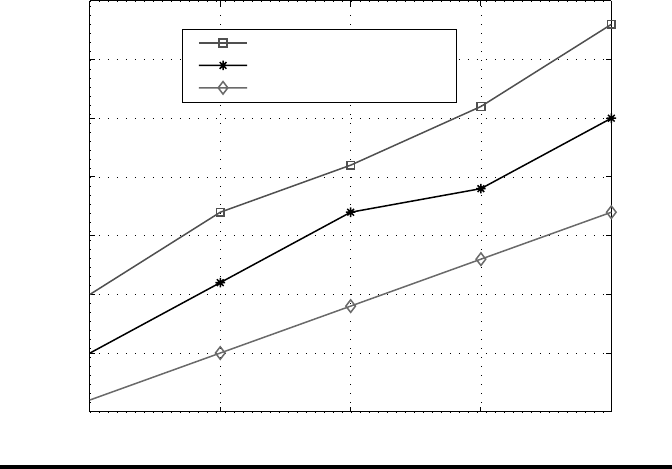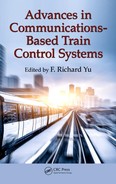
Novel Communications-Based Train Control System ◾ 145
existing scheme gives the highest average service discontinuity time duration com-
pared to the other schemes. is is because the CoMP is not used in this scheme.
Our proposed scheme gives better average service discontinuity time duration com-
pared with the CoMP-based greedy scheme. is is because CoMP improves ser-
vice availability and no ping-pong hando happens in the CBTC system under the
proposed scheme, which consequently decreases the average service discontinuity
time duration.
7.7 Conclusion
Train–ground communication is one of the key technologies in CBTC systems.
Unreliable wireless communications and frequent handos have signicant
impacts on the train control performance in CBTC systems. In this chapter, using
recent advances in CoMP, we proposed a novel CBTC system, in which a train
can communicate with a cluster of base stations simultaneously to enhance the
train control performance of CBTC systems. In order to mitigate the impacts of
wireless communications on CBTC performance, we took a cross-layer design
approach to optimize the control performance in CBTC systems. Unlike the exist-
ing works on CoMP that use traditional design criteria, such as network capacity,
we used linear quadratic cost for the train controller as the performance measure.
2500
3000 3500 4000
4500
3
4
5
6
7
8
9
10
Trip distance (m)
Service discontinuity (s)
Existing scheme
CoMP-based greedy scheme
Proposed scheme
Figure7.11 Average service discontinuity time duration in different schemes.
146 ◾ Advances in Communications-Based Train Control Systems
We jointly considered base station cluster selection and hando decision issues
in CBTC systems. An optimal guidance trajectory calculation scheme was pro-
posed in the train control procedure to further improve the performance of CBTC
systems. Simulation results were presented to show that the proposed approach
can signicantly improve the train control performance and increase the railway
capacity.
References
1. J. Huang, J. Ma, and Z. Zhong. Research on handover of GSM-R network under
high-speed scenarios. Railway Commun. Signals, 42:51–53, 2006.
2. C. Yang, L. Lu, C. Di, and X. Fang. An on-vehicle dual-antenna handover scheme for
high-speed railway distributed antenna system. In Proc. IWCMC’10, Caen, France, 2010.
3. Z. Li, F. R. Yu, B. Ning, and T. Tang. Cross-layer hando design in MIMO-enabled
WLANs for communication-based train control (CBTC) systems. IEEE J. Sel. Areas
Commun., 30(4):719–728, 2012.
4. R. Irmer, H. Droste, P. Marsch, M. Grieger, G. Fettweis, S. Brueck, H.-P. Mayer
et al. Coordinated multipoint: Concepts, performance, and eld trial results. IEEE
Comm. Mag., 49(2):102–111, 2011.
5. J. Tang and X. Zhang. Cross-layer modeling for quality of service guarantees over
wireless links. IEEE Trans. Wireless Commun., 6(12):4504–4512, 2007.
6. J. Tang and X. Zhang. Cross-layer resource allocation over wireless relay networks for
quality of service provisioning. IEEE J. Sel. Areas Commun., 25(4):645–657, 2007.
7. A. L. Toledo and X. Wang. TCP performance over wireless MIMO channels with
ARQ and packet combining. IEEE Trans. Mobile Comput., 5(3):208–223, 2006.
8. F. R. Yu, B. Sun, V. Krishnamurthy, and S. Ali. Application layer QoS optimization
for multimedia transmission over cognitive radio networks. ACM/Springer Wireless
Networks, 17(2):371–383, 2011.
9. P. Dorato, V. Cerone, and C. Abdallah. Linear-Quadratic Control: An Introduction.
Simon & Schuster, New York, 1990.
10. H. Dong, B. Ning, B. Cai, and Z. Hou. Automatic train control system develop-
ment and simulation for high-speed railways. IEEE Circuits and Systems Magazine,
10(2):6–18, 2010.
11. M. Puterman. Markov Decision Processes: Discrete Stochastic Dynamic Programming.
John Wiley & Sons, New York, 1994.
12. Q. Zhao, L. Tong, A. Swami, and Y. Chen. Decentralized cognitive MAC for oppor-
tunistic spectrum access in ad hoc networks: A POMDP framework. IEEE J. Sel.
Areas Commun., 25(5):589–600, 2007.
13. P. G. Howlett, P. J. Pudney, and X. Vu. Local energy minimization in optimal train
control. Automatica, 45(11):2692–2698, 2009.
14. P. Howlett. e optimal control of a train. Ann. Oper. Res., 98(1–4):65–87, 2000.
15. Q. Song and Y.-D. Song. Data-based fault-tolerant control of high-speed trains with
traction/braking notch nonlinearities and actuator failures. IEEE Trans. Neural Net.,
22(12):2250–2261, 2011.
16. F. Babich, G. Lombardi, and E. Valentinuzzi. Variable order Markov modeling for
LEO mobile satellite channels. Electron. Lett., 35(8):621–623, 1999.
Novel Communications-Based Train Control System ◾ 147
17. F. Babich and G. Lombardi. A measurement based Markov model for the indoor
propagation channel. In Proc. IEEE VTC, volume 1, Phoenix, AZ, May 1997.
18. H. S. Wang and P.-C. Chang. On verifying the rst-order Markovian assumption for
a Rayleigh fading channel model. IEEE Trans. Veh. Tech., 45(2):353–357, 1996.
19. H. S. Wang and N. Moayeri. Finite-state Markov channel—A useful model for radio
communication channels. IEEE Trans. Veh. Tech., 44(1):163–171, 1995.
20. C. Pimentel, T. H. Falk, and L. Lisbôa. Finite-state Markov modeling of correlated
Rician-fading channels. IEEE Trans. Veh. Tech., 53(5):1491–1501, 2004.
21. Y. L. Guan and L.F. Turner. Generalized FSMC model for radio channels with cor-
related fading. IEE Proc. Commun., 146(2):133–137, 1999.
22. C. D. Iskander and P. T. Mathiopoulos. Fast simulation of diversity Nakagami fading
channels using nite-state Markov models. IEEE Trans. Broadcasting, 49(3):269–277,
2003.
23. J. Yang, A. K. Khandani, and N. Tin. Statistical decision making in adaptive modu-
lation and coding for 3G wireless systems. IEEE Trans. Veh. Tech., 54(6):2066–2073,
2005.
24. L.-C. Wang and C.-J. Yeh. 3-Cell network MIMO architectures with sectorization
and fractional frequency reuse. IEEE J. Sel. Areas Commun., 29(6):1185–1199, 2011.
25. D. Gesbert, S. Hanly, H. Huang, S. Shamai Shitz, O. Simeone, and W. Yu. Multi-
cell MIMO cooperative networks: A new look at interference. IEEE J. Sel. Areas
Commun., 28(9):1380–1408, 2010.
26. K. Woradit, T. Q. S. Quek, W. Suwansantisuk, H. Wymeersch, L. Wuttisittikulkij,
and M. Z. Win. Outage behavior of selective relaying schemes. IEEE Trans. Wireless
Commun., 8(8):3890–3895, 2009.
27. S. Lin, D. Costello, and M. Miller. Automatic-repeat-request error-control schemes.
IEEE Comm. Mag., 22(12):5–17, 1984.
28. C. Rico-Garcia and O. K. Tonguz. Increasing safety and eciency of railway. InProc.
IEEE ICC’12 Workshop on Intelligent Vehicular Networking: V2V/V2I Comm. App.,
Ottawa, Canada, June 2012.
29. H. J. Kushner and G. G. Yin. Stochastic Approximation and Optimization of Random
Systems. Springer, New York, 2003.
30. G. H. Lee, I. P. Milroy, and A. Tyler. Application of Pontryagin’s maximum principle
to the semi-automatic control of rail vehicles. In Proc. 2nd Conference on Control
Engineering, Newcastle, Australia, 1982.
31. L. Zhu, F. R. Yu, and B. Ning. A seamless hando scheme for train-ground commu-
nication systems in CBTC. In Proc. IEEE VTC, Ottawa, Canada, September 2010.
32. J.-M. Chung, M. Kim, Y.-S. Park, M. Choi, S. Lee, and H. S. Oh. Time coordi-
nated V2I communications and handover for WAVE networks. IEEE J. Sel. Areas
Commun., 29(3):545–558, 2011.
This page intentionally left blankThis page intentionally left blank
..................Content has been hidden....................
You can't read the all page of ebook, please click here login for view all page.
